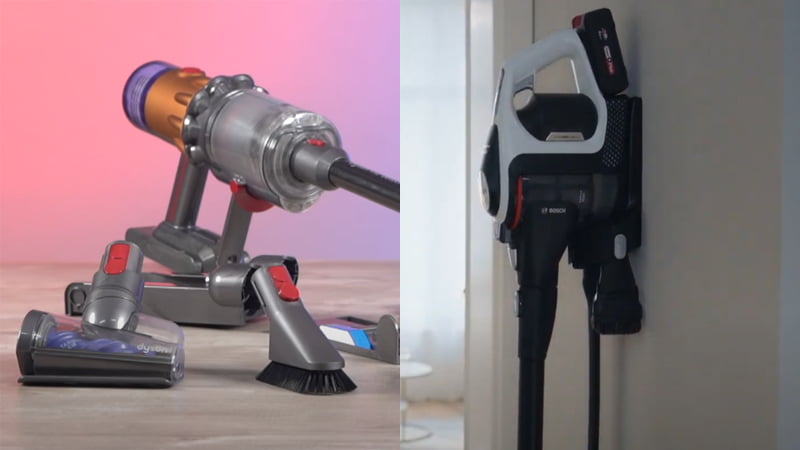Regarding the realm of cordless vacuum cleaners, Dyson reigns supreme in the American market, whereas Bosch commands the lion’s share in many European markets. I put the Dyson V12 vs Bosch Serie 8, two of their bestsellers, through the wringer to see which was better.
The Dyson V12 came on the heels of the Dyson V15 (sounds funny, right?) and is the latest model of the Dyson cord-free vacuum series. This one is considered the V15’s more compact iteration since it encapsulates all the latest bells and whistles of the brand, such as a piezo sensor and Laser Detect technology, but is designed with compactness and lightweight in mind.
The Bosch Series 8, the runner-up, is also quite pricey, but it has enough reasons to justify it. It’s lightweight, maneuverable, and has two batteries for up to 80 minutes of runtime. Another hot spot is the quick charger, which can give the battery a full charge in about 50 minutes.
Dyson V12 Vs Bosch Serie 8: Comparison Chart




Dyson V12 Vs Bosch Serie 8: Differences
The Dyson V12 wins 3-0 and has one draw against the Bosch Serie 8. It performs impressively across various surface types, comes with a great collection of attachments, sports a combination of a sealed system with a HEPA-grade filter, and can automatically adjust its suction.
Cleaning Performance
Winner: Dyson V12
Suction Power & Floorhead
Operating at its maximum power, the Dyson V12 can generate up to 150 air watts (AW), whereas the Bosch Serie 8 is on par with the Dyson V11, its predecessor, which boasts a slightly higher output at 185 AW.
In terms of floorhead, the Bosch Serie 8 is equipped solely with one multi-surface cleaning head, known as the All-Floor HighPower head, which incorporates a motorized brush roller. Upon initial use, I found the brush roll reacted with a slight delay – it activated approximately two seconds after I pressed the power button.
The Dyson V12, on the other hand, is ahead of the game with two floorheads: a “Laser Slim Fluffy” cleaner head (including a soft roller) and a Motorbar cleaner head (featuring a standard roller). Both have enhancements over previous generations (more on that later).
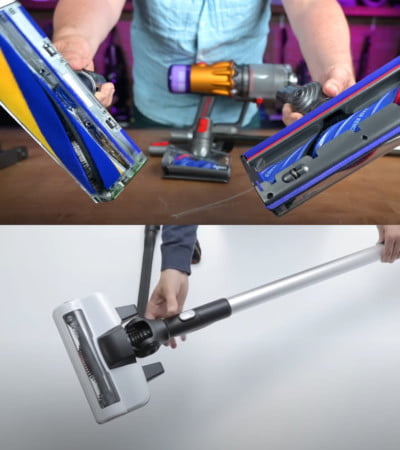
Hard Floor
I used the V12 with the Laser Slim Fluffy and found it worked fantastically on this flooring type. It could handle almost all types of debris with ease. It effectively tackled nearly all types of debris. Only a minor amount of fine particles were scattered forward, but they were swiftly captured in the subsequent sweep.
On the flip side, the Bosch Series 8 performed a bit worse. It still did a good job on fine and small debris – about 98% of all debris was sucked up in the forward pass. But a moderate amount of sizeable particles were pushed around due to the brush’s narrow slot, a typical issue with models lacking soft rollers.
Carpet
When tested on my low-pile carpet, the Bosch Series 8 picked up about 92% of the total debris in the first sweep. I found it necessary to do a few additional passes to achieve complete cleanliness – this is still an acceptable result. But on the high-pile carpet, its roller stopped a few times when it was in the highest power mode. Then I switched to its lower power mode, and this stopped happening, but its cleaning performance deteriorated significantly.
As for the Dyson V12, similar to the hard floor, its performance was also excellent. Most of the debris was gone, but there was still a small amount of fine debris left behind after the first pass.
Hair Test
In this experiment, I scattered hair strands of various lengths across the cleaning path, and they were effortlessly collected in a single forward-and-backward sweep. The distinguishing factor, however, is the capacity to mitigate hair wrap issues. Dyson V12’s Motorbar floorhead is equipped with polycarbonate teeth, which send most of the vacuumed hair into its dustbin, resulting in reduced maintenance.
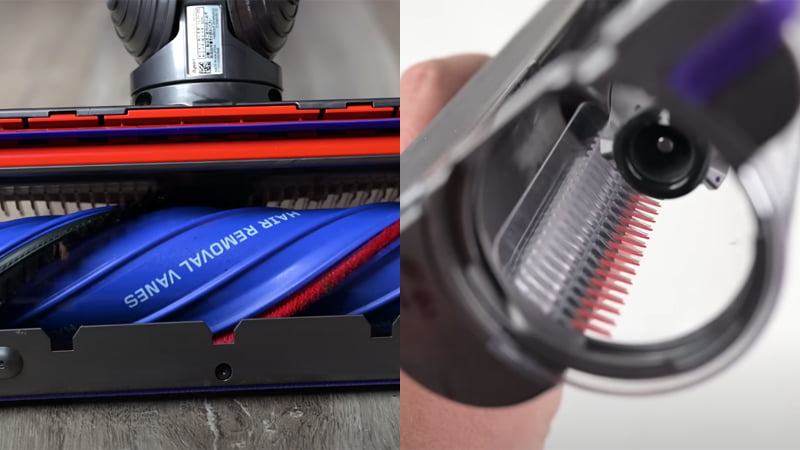
Meanwhile, the Bosch Serie 8’s nozzle has no anti-tangle technology, which led to a considerable amount of long hair wrapped around its roller by the end of the day.
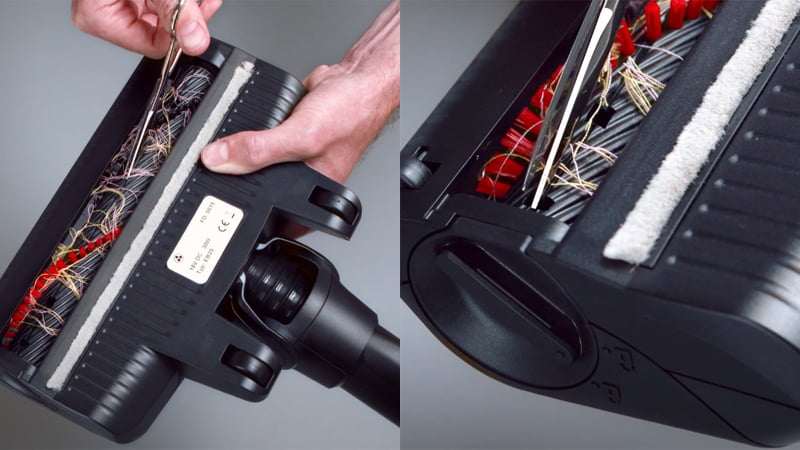
Design & Usability
Winner: Tie
Attachments & Storage
| Dyson V12 | Bosch Serie 8 |
|---|---|
| Laser Slim Fluffy floorhead Motorbar floorhead Hair screw tool Crevice tool Combination tool Wand clip Docking station & Charger Removable battery (x1) | All-Floor HighPower head Crevice tool 2 in 1 furniture & upholstery tool XXL upholstery tool Quick charger Docking station & Charger Removable battery (x2) |
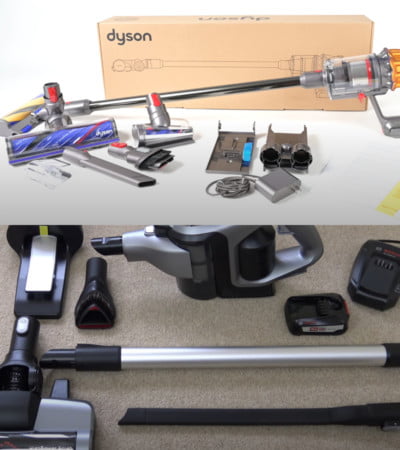
A shared feature between the Dyson V12 and Bosch Serie 8 is the provision of a wall bracket that doubles as a holder and charging station for the vacuum. By installing the bracket on a wall in close proximity to an outlet, you can charge the vacuum whenever it is parked there.
The wall bracket provides a neat and organized spot to charge/store the vacuum and keeps it out of reach of your curious little ones and furry companions. But, in fact, it isn’t a preferred option for everyone, particularly for those residing in rental properties where drilling into walls is forbidden. I also don’t feel comfortable drilling into my wall (which is why I always give props to models that come with a self-standing charging station, like the Samsung Jet 90, or ones that can stand on their own, like the Shark Stratos).
Fortunately, the batteries on these models can charge independently, and you can just put the battery on the docking station (without screwing it to the wall) and store the vacuum in your cupboard.
Another thing worth mentioning is the Dyson V12’s docking station’s capacity to accommodate two attachments, with the vacuum itself able to secure an additional two tools via the wand clip. Meanwhile, the Bosch Series 8’s bracket can only hold the vacuum, which implies all its useful attachments will need to be stored elsewhere.
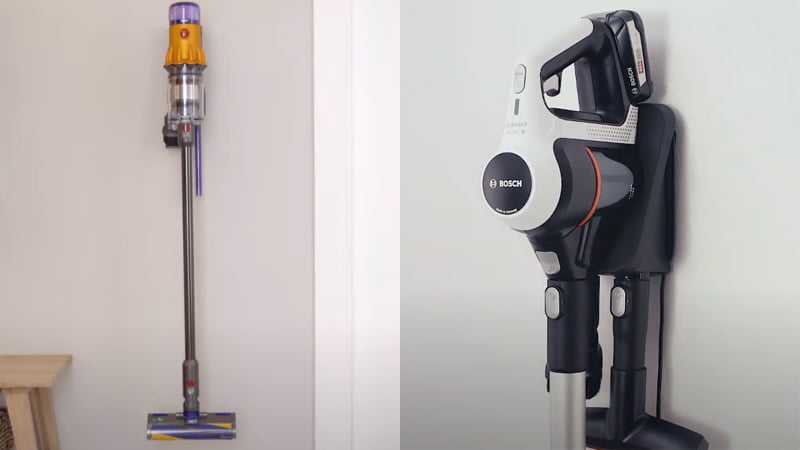
Weight & Maneuverability
Weight, no doubt, is among the most important factors. The Dyson V12 vs Bosch Serie 8 weigh 5.3 and 7 pounds, respectively. The first one, as mentioned above, was designed with lightweight and compactness in mind, and it truly felt like a toy in my hand. Despite the Bosch Serie 8 leaning towards the heavier side, I discovered it to be surprisingly easy to maneuver, likely attributed to its well-distributed weight. Also, its handle is located directly on the motor, giving me an ergonomically pleasing feel when holding it.
Both are 2-in-1 vacuums that can be morphed into handheld vacuums in just a few steps. In this configuration, the Dyson V12 edges ahead due to its lighter weight, and I could use it to clean the ceiling with just one hand for a long time without experiencing any noticeable fatigue. As for the Bosch Serie 8, I had to keep switching hands every 15 minutes. The Dyson V12 was also easier to go further under furniture.
Battery Life
Dyson V12 vs Bosch Serie 8 are announced to be able to run continuously for 60 and 40 minutes, respectively. But I have long realized that the battery life manufacturers quote is seldom achieved in practical use. Don’t misconstrue my meaning—I don’t mean they tricked us. Rather, it’s simply a marketing strategy. Manufacturers typically disclose battery life estimates based on vacuum use with the suction-only tool and at the lowest power setting. Then I tested each with the main nozzle, and here’s what I got:
| Dyson V12 | Bosch Serie 8 | |
|---|---|---|
| Minimum Battery Life | ≈ 12 mins | ≈ 9 mins |
| Maximum Battery Life | ≈ 41 mins | ≈ 34 mins |
| Charging Time | ≈ 4 hours | ≈ 5 hours |
As you can see, it is clear that the Dyson V12 has a more impressive battery life than the Bosch Serie 8. But don’t forget that the second one comes with two removable batteries, so its runtime can be doubled. Additionally, it comes with a quick charger that significantly shortens the charging time from 5 hours to around 50 minutes right out of the box.
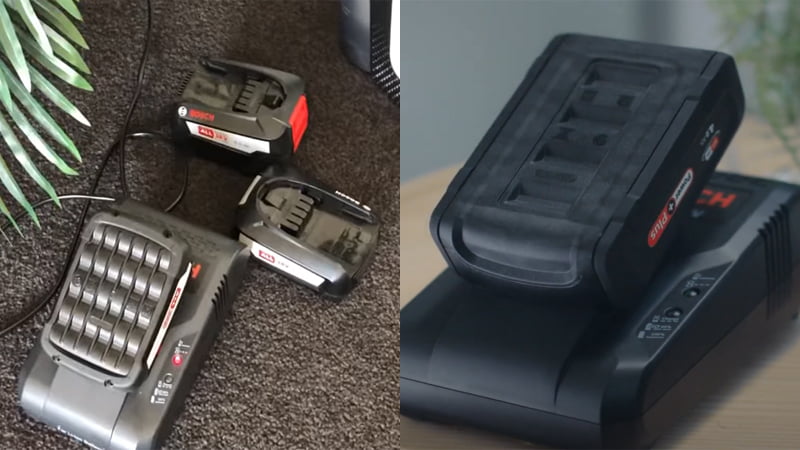
The Dyson V12, on the other hand, is also powered by a removable battery. So you can also say goodbye to downtime by swapping out the batteries, but the spare one needs to be purchased separately (on Dyson’s website).
Dustbin & Filtration System
Winner: Dyson V12
The Bosch Series 8 features a 0.4-liter dustbin, closely matching the Dyson V12’s 0.35-liter collection cup in capacity. They are quite small and need to be emptied often.
Emptying the Bosch Serie 8’s dustbin took quite an effort and left much to be desired. I had to disassemble the dustbin entirely (by pushing down a release button) and remove the filter before letting the contents go. For such a small dust cup, I needed an easier mechanism.
Fortunately, it’s considerably easier to empty the Dyson V12’s canister. All I had to do was push a lever down a few times, and all the dirt picked up from my floors would be sent straight down to the trash can below.
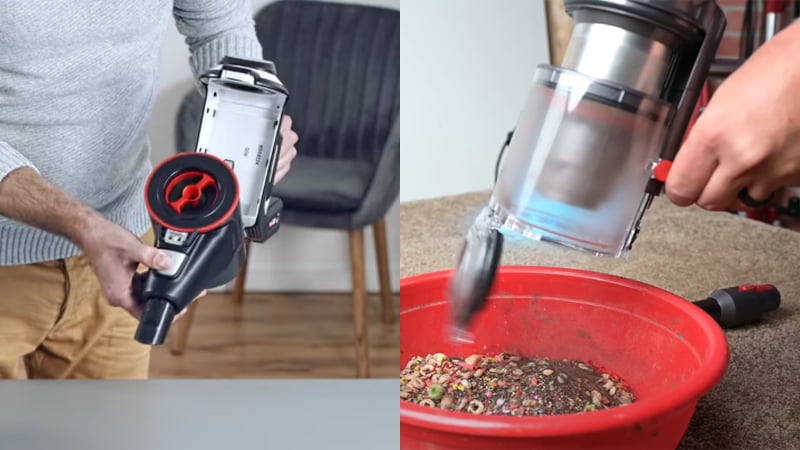
The Dyson V12’s HEPA filter is located at the top of the handheld part, which is easy to access and remove. This filter is washable, and the LCD screen will tell you when it needs to be cleaned.
The Bosch Serie 8’s filtration system isn’t labeled HEPA, but it still claims that the air is 99.9% clean when it comes out of the device. It includes a fine mesh canister with a large pleated filter inside, which can’t be washed with water. To clean it, just turn the red handle on top (called RotationClean Tech) to knock all the dust out of its nooks and crannies.
As a result, you won’t need to knock the Bosch Serie 8’s filter against the side of a trash can, which means no dust clouds will result from this process. This process is quite quick and convenient, but I wonder if it can really remove everything from the filter and how the vacuum’s performance will be if dust particles permanently stay there.
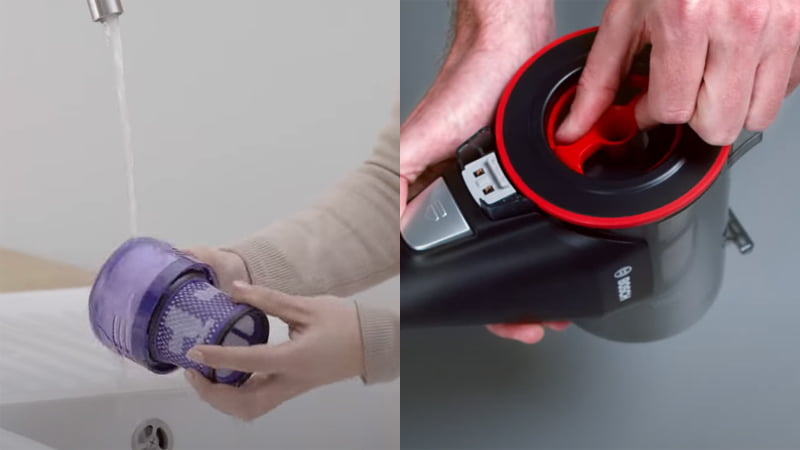
Utilities
Winner: Dyson V12
User Interface
The Dyson V12 has a futuristic and elegant LCD screen that displays battery life in percent, the current power mode, maintenance alerts related to the roller and filter, and data on vacuumed dust particles by number and size. Yes, it could tell me how much and what size dust particles are vacuumed, so I knew I should spend more time cleaning a particular area. There is a small button on the screen that is used to switch between modes.
One of the most welcome changes to the V12 is the addition of a power button, replacing the previous model’s trigger mechanism. So to activate the vacuum, I just pressed the button once and made another press to turn it off. That way, it solved a widespread issue for the earlier Dyson Stick vacuum – hand fatigue caused by holding down a trigger for too long. But it would be better if this button was placed somewhere that I could reach without using my other hand.
The Bosch Serie 8 just has a small LED light on the top that shows the battery status, but a display would be more appropriate for such an expensive machine. It uses a pistol-like trigger, but unlike the Dyson models, you will only need to press it once, and it will lock immediately, so you won’t need to press and hold it continuously. There is a button on top used to activate Turbo mode, which is easy to reach with the thumb.
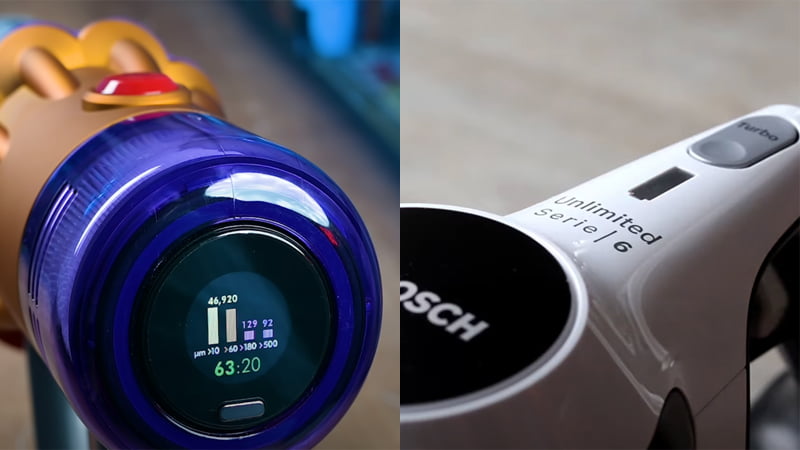
Power Mode
The Dyson V12 has three power modes: eco, auto, and boost, with the auto setting standing out as a key differentiator. Unique to this model is the ability to dynamically modulate its suction based on real-time dust density levels, which is made possible by an integrated piezo sensor. I found it particularly effective for carpet cleaning.
On the other hand, the Bosch Serie 8 has two basic cleaning modes: standard and turbo, and you can toggle between them by pressing a button, as mentioned above.
A Quick Rundown Of Dyson V12
A Quick Rundown Of Bosch Serie 8
Product Videos
Related Articles to Dyson V11
- Electrolux Pure Q9 Vs Dyson V11: The Awesome Debate
- Dyson V11 Torque Drive vs Torque Drive Plus: Unveiling The Differences And Choosing The Right Model For You
- Proscenic P11 vs Dyson V11: Which Is Your Best Bet?
- Dyson V11 Torque Drive Vs V10 Animal: An Honest Cleaning Power Comparison
- Dyson V8 Animal Vs V11 Torque Drive: Design and Convenience Showdown
- Dreame V11 vs Dyson V11: Comparable Quality At Different Prices
- Tineco Pure One S11 vs Dyson V11: A Comprehensive Comparison
- Samsung Jet 75 Pet Vs Dyson V11: Which Vacuum Cleaner Has A Greater Advantage?
- Samsung Jet 75 vs Dyson V11: Which Is The Better Buy?
- Hoover H-FREE 500 vs Dyson V11: Honest Reviews And Detailed Comparison
- Vorwerk Kobold Vk200 vs Dyson V11: Both Are Potent Vacuums, But There Is Only 1 Winner!
- Karcher VC4s vs Dyson V11: Let’s Choose The Vacuum That Best Fits Your Needs
- Miele Triflex HX1 vs Dyson V11: Which Is Your Best Best?
- Dyson V7 vs V11: Which One Is Right For You?
- Tineco S11 vs Dyson V11: A Battle Between Well-known Cordless Stick Vacuums
- The Only Dyson V11 vs Philips 8000 Comparison You Need!
- Kogan Z11 vs Dyson V11: Which Vacuum Is Worth The Money?
- JIMMY JV85 Pro vs Dyson V11: Dyson Encounters A Serious Opponent
- Xiaomi G11 vs Dyson V11: Which Is The Better One?
- Samsung Jet 60 Vs Dyson V11: Discover The Best Vaccum
- Xiaomi Jimmy JV83 Vs Dyson V11: The Ultimate Face-off Between Powerhouse Vacuums
- Tineco A11 Vs Dyson V11 – Which Vacuum Cleaner Reigns Supreme?
- Samsung Bespoke Jet Vs Dyson V11: A Head-To-Head Comparison
- Dyson V8 vs V11: What’s the Best Bang for Your Buck?
- Dyson V12 vs V11: Ultimate Side-by-side Comparison
- Tineco S12 Vs Dyson V11: Which Is The Better Cordless Vacuum?
- Xiaomi G10 Vs Dyson V11: Discover Your Perfect Vacuum Match
- Kobold VB100 Vs Dyson V11: Which Vacuum Cleaner is Worth Your Investment?
- Dyson V10 vs V11: Which Should You Buy?
- Xiaomi V10 vs Dyson V11: A Head-To-Head Comparison
Related Articles to Bosch Serie 8
References:
- Bosch Serie 8: https://www.amazon.co.uk/Bosch-BBS812PCK-Bosch-BBS812PCK-Scopper-Unlimited-Batteries/dp/B082VLZ955

Victor K. Giles is a leading consultant and expert in vacuum cleaner technology with over a decade of experience. As a mechanical engineering graduate in the University of Michigan, he specializes in product development, design optimization, and performance analysis. Victor collaborates with manufacturers and educates consumers, making her a sought-after guest speaker at industry events. His work has been featured in renowned publications, and he shares his expertise on his blog, “The Vacuum Teria”. Victor’s passion for cleaner, healthier living spaces drives his to help clients choose the best vacuum solutions for their needs.
